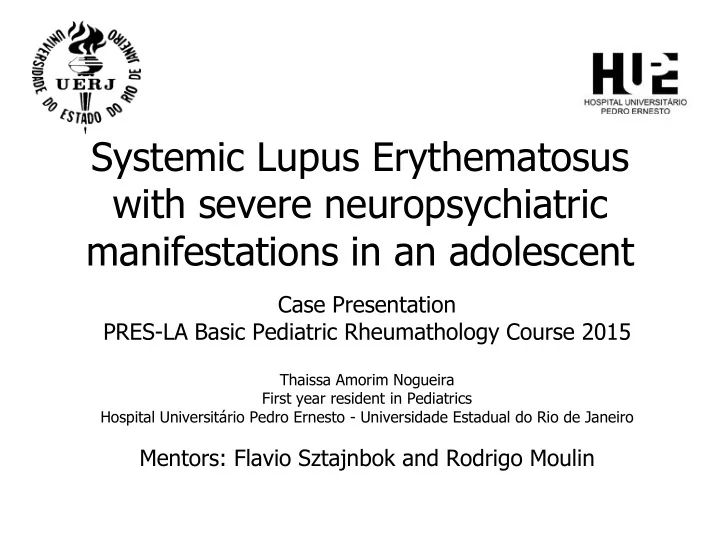

Systemic Lupus Erythematosus with severe neuropsychiatric manifestations in an adolescent Case Presentation PRES-LA Basic Pediatric Rheumathology Course 2015 Thaissa Amorim Nogueira First year resident in Pediatrics Hospital Universitário Pedro Ernesto - Universidade Estadual do Rio de Janeiro Mentors: Flavio Sztajnbok and Rodrigo Moulin
Identification: ACAN, female, 12 years. History: • Patient presented with the diagnosis of SLE: hemolytic anemia, arthritis, pericarditis, nephritis, ANA, AntiDNA, lupus anticoagulant. • Admitted to undergo pulse therapy with methylprednisolone. At this stage she presented with low blood pressure showing myocarditis at echocardiogram. • Four days later she presented with lowered consciousness levels, diffuse muscle spasms, conjugate gaze deviation and decreased oxygen saturation. She then evolved with seizures, psychosis, and psychomotor agitation refractory to high doses of sedation .
• She was admitted at the ICU and underwent a dose of IVIG 2 g/kg. • Treatment with cyclophosphamide was initiated as soon as clinical stability was achieved. • Progressive decrease in sedation was made, but she persisted with no interaction, no spontaneous eye opening, showing shoulder girdle and upper limbs hypertonia, and was kept intubated for airways safety. Brain contrasted CT: Normal Brain and spinal cord angio MRI: Normal
• After two cycles of pulse therapy with methylprednisolone and cyclophosphamide (500mg/m2, three weeks apart) she maintained neurological symptoms and severe hemolytic anemia, but showed partial improvement in renal function. 23/02 29/03 72 49 Urea (mg/dL) Creatinine (mg/dL) 1,3 0,8 Hemoglobin (g/dL) 7 5,8 20,8 17,6 Hematocrit (%) 6.200/868 6.800/204 Leuko/Lympho (cel/mm3) 35.000 190.000 Platelets (/mm3) 1,5 - Urinary protein/creatinine ratio
• Rituximab (750mg/m2; max 1g) was recommended. • After one week: normal renal function and partial improvement of neurological symptoms - she started making interactions, answering to demands and frequency of seizures was decreased. After Immunoglobulin Before Rituximab Rituximab 20 mg/dl A 40 mg/dl (N) (L) 807 mg/dl 325 mg/dl G (N) (L) 27 mg/dl 5,46 mg/dl M (N) (L) 115 KU/L 32,1 UI/ml E (N) (L) 0,1% CD 20 not measured
Two weeks later, she underwent another cycle of pulse therapy with rituximab, cyclophosphamide and methylprednisolone. She was discharged three weeks after that when she showed complete improvement of the neuropsychiatric symptoms, no hemolytic anemia and normal function at the echocardiogram. 23/02 29/03 08/06 Urea (mg/dL) 72 49 35 Creatinine (mg/dL) 1,3 0,8 0,3 7 5,8 12,6 Hemoglobin (g/dL) Hematocrit (%) 20,8 17,6 38,6 6.200/868 6.800/204 15.000/3000 Leuko/Lympho (cel/mm3) 35.000 190.000 384.000 Platelets (/mm3) Urinary protein/creatinine 1,5 - 0,01 ratio
Questions for the audience What is your experience with neuropsychiatric symptoms • in SLE? What is your experience in using rituximab for the • treatment of SLE? At which time should it be introduced? • Role of therapeutic plasma exchange? • Should have brain auto-antibodies be searched in this • case?
Recommend
More recommend